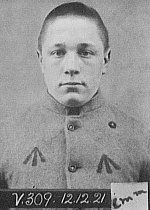'New Jack the Stripper Theory'
Crime author thinks killer was Welsh child murderer
The unsolved murders of seven women in the West London area over four decades ago continues to attract the attention of crime writers. Having in the past been linked to the Profumo affair and boxer Freddie Mills, a new theory now claims that Harold Jones, a man responsible for the murder of two young girls in Abertillery when he was 15, could have been Jack the Stripper.
Neil Milkins, a crime author, from Wales was researching the life of Harold Jones for his book 'Every Mother’s Nightmare' which tells how the killing by Jones of eight-year-old Freda Burnell and 11-year-old Florence Little in 1921 rocked the tiny mining community to its very core. Jones was released from Wandsworth prison in 1941 in the hope that he would become involved in the war effort but instead he vanished. He turned up in Fulham in the late 1940s calling himself Harry Stevens, and stayed at an address in Hestercombe Avenue until 1962, at which point he disappeared again. Mr Milkins, despite much research has been unable to find any details of Harold Jones whereabouts from 1962 - 65 the same time that the 'Hammersmith Nudes Murders' shocked sixties London.
The victims were usually found naked apart from their stockings having been choked, some of their teeth knocked out and with traces of paint on their bodies. The first death was 22-year-old Welsh girl Gwynneth Rees who was found naked but for a nylon stocking, on a garbage dump on the side of the Thames in November 1963. A post-mortem revealed several teeth were missing and she had been strangled. Jack The Stripper is also believed to be responsible for the deaths of Hannah Tailford who was fished from the River Thames at Hammersmith, Irene Lockwood, 26, who was found on the foreshore at Chiswick, and Helen Bathelemy who was dumped in a Brentford alley. Later that same year police found the naked body of Margaret McGowan, 21, buried under rubble in a Kensington car park, and in February 1965 Bridie O'Hara, 28, was found naked and hidden under bracken on an embankment in Acton.
None had been sexually assaulted, which, according to Milkins, ties in with a report on Jones by a senior prison medical officer that suggested acts of cruelty and killing gave him all the sexual gratification he needed. Jones died in 1971 of bone cancer in Hammersmith.
The crimes were linked to the Heron Trading Estate in Acton where the police believed some of the bodies had been kept. Jones was described on his death certificate as a 'care taker' and Mr. Milkins is currently trying to find out if he would have had access to the paint shop in the estate.
Nobody was ever charged with these murders but police ceased their investigations following the suicide of a security guard. Since then, as with the original Jack the Ripper, conspiracy theorists have come up with ever more colourful explanations for who was the killer.
Alfred Hitchcock is believed to have loosely based his thriller ‘Frenzy’ on these gruesome events.
August 22, 2008
Related links
|
